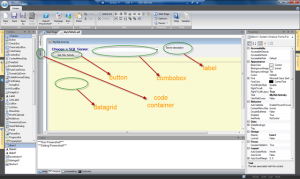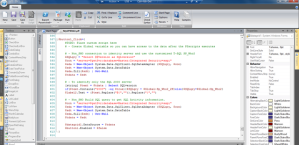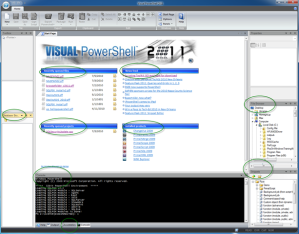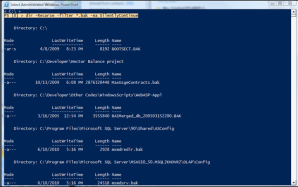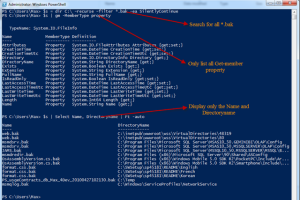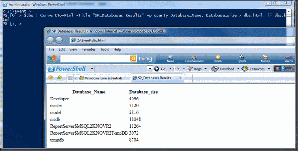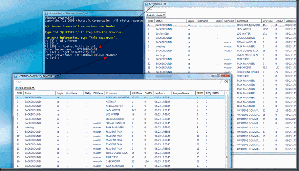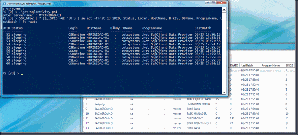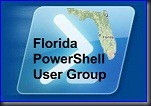# ==============================================================================================
# Microsoft PowerShell Source File -- Created with SAPIEN Technologies PrimalScript 2009
# NAME: get-sqlActivity.ps1
# AUTHOR: Max Trinidad , PutItTogether.net
# DATE : 6/25/2010
#
# COMMENT: This is a customized version of SP_Who2 use in a PowerShell script to assist in
# monitoring users activities. When using the $Global:varname will allow you to work with the
# values pull from the custmomized T-SQL SP_Who2 script.
# ==============================================================================================
# - Create Global variable so you can have access to the data after the PSscripts executes
$Global:Sp_Who2 = $null;
# - Customized T-SQL SP_Who2
$SQLqry = @"
--======================================================================
-- SQL Source File -- Created with SAPIEN Technologies PrimalScript 2009
-- NAME: SP_Who2_Custom.sql
-- AUTHOR: Max Trinidad , PutItTogether
-- DATE : 6/24/2010
--
-- COMMENT: Customized SP_WHO2 but the onli change was to rename the dup
-- 'SPID' column to 'SPID2'.
--======================================================================
USE [Master]
GO
/****** Object: StoredProcedure [sys].[sp_who2] Script Date: 06/24/2010 09:46:26 ******/
SET ANSI_NULLS ON
GO
SET QUOTED_IDENTIFIER ON
GO
--Alter procedure [sys].[sp_who2] --- 1995/11/03 10:16
Declare
@loginame nvarchar(128) --sysname = NULL
--as
set nocount on
declare
@retcode int
declare
@sidlow varbinary(85)
,@sidhigh varbinary(85)
,@sid1 varbinary(85)
,@spidlow int
,@spidhigh int
declare
@charMaxLenLoginName varchar(6)
,@charMaxLenDBName varchar(6)
,@charMaxLenCPUTime varchar(10)
,@charMaxLenDiskIO varchar(10)
,@charMaxLenHostName varchar(10)
,@charMaxLenProgramName varchar(10)
,@charMaxLenLastBatch varchar(10)
,@charMaxLenCommand varchar(10)
declare
@charsidlow varchar(85)
,@charsidhigh varchar(85)
,@charspidlow varchar(11)
,@charspidhigh varchar(11)
-- defaults
select @retcode = 0 -- 0=good ,1=bad.
select @sidlow = convert(varbinary(85), (replicate(char(0), 85)))
select @sidhigh = convert(varbinary(85), (replicate(char(1), 85)))
select
@spidlow = 0
,@spidhigh = 32767
--------------------------------------------------------------
IF (@loginame IS NULL) --Simple default to all LoginNames.
GOTO LABEL_17PARM1EDITED
-- select @sid1 = suser_sid(@loginame)
select @sid1 = null
if exists(select * from sys.syslogins where loginname = @loginame)
select @sid1 = sid from sys.syslogins where loginname = @loginame
IF (@sid1 IS NOT NULL) --Parm is a recognized login name.
begin
select @sidlow = suser_sid(@loginame)
,@sidhigh = suser_sid(@loginame)
GOTO LABEL_17PARM1EDITED
end
--------
IF (lower(@loginame collate Latin1_General_CI_AS) IN ('active')) --Special action, not sleeping.
begin
select @loginame = lower(@loginame collate Latin1_General_CI_AS)
GOTO LABEL_17PARM1EDITED
end
--------
IF (patindex ('%[^0-9]%' , isnull(@loginame,'z')) = 0) --Is a number.
begin
select
@spidlow = convert(int, @loginame)
,@spidhigh = convert(int, @loginame)
GOTO LABEL_17PARM1EDITED
end
--------
raiserror(15007,-1,-1,@loginame)
select @retcode = 1
GOTO LABEL_86RETURN
LABEL_17PARM1EDITED:
-------------------- Capture consistent sysprocesses. -------------------
select
spid
,status
,sid
,hostname
,program_name
,cmd
,cpu
,physical_io
,blocked
,dbid
,convert(sysname, rtrim(loginame))
as loginname
,spid as 'spid_sort'
, substring( convert(varchar,last_batch,111) ,6 ,5 ) + ' '
+ substring( convert(varchar,last_batch,113) ,13 ,8 )
as 'last_batch_char'
,request_id
into #tb1_sysprocesses
--from sys.sysprocesses_ex with (nolock)
from sys.sysprocesses with (nolock)
if @@error <> 0
begin
select @retcode = @@error
GOTO LABEL_86RETURN
end
--------Screen out any rows?
if (@loginame in ('active'))
delete #tb1_sysprocesses
where lower(status) = 'sleeping'
and upper(cmd) in (
'AWAITING COMMAND'
,'LAZY WRITER'
,'CHECKPOINT SLEEP'
)
and blocked = 0
--------Prepare to dynamically optimize column widths.
select
@charsidlow = convert(varchar(85),@sidlow)
,@charsidhigh = convert(varchar(85),@sidhigh)
,@charspidlow = convert(varchar,@spidlow)
,@charspidhigh = convert(varchar,@spidhigh)
select
@charMaxLenLoginName =
convert( varchar
,isnull( max( datalength(loginname)) ,5)
)
,@charMaxLenDBName =
convert( varchar
,isnull( max( datalength( rtrim(convert(varchar(128),db_name(dbid))))) ,6)
)
,@charMaxLenCPUTime =
convert( varchar
,isnull( max( datalength( rtrim(convert(varchar(128),cpu)))) ,7)
)
,@charMaxLenDiskIO =
convert( varchar
,isnull( max( datalength( rtrim(convert(varchar(128),physical_io)))) ,6)
)
,@charMaxLenCommand =
convert( varchar
,isnull( max( datalength( rtrim(convert(varchar(128),cmd)))) ,7)
)
,@charMaxLenHostName =
convert( varchar
,isnull( max( datalength( rtrim(convert(varchar(128),hostname)))) ,8)
)
,@charMaxLenProgramName =
convert( varchar
,isnull( max( datalength( rtrim(convert(varchar(128),program_name)))) ,11)
)
,@charMaxLenLastBatch =
convert( varchar
,isnull( max( datalength( rtrim(convert(varchar(128),last_batch_char)))) ,9)
)
from
#tb1_sysprocesses
where
spid >= @spidlow
and spid <= @spidhigh
--------Output the report.
EXEC(
'
SET nocount off
select
SPID --= convert(char(5),spid)
,Status =
CASE lower(status)
When ''sleeping'' Then lower(status)
Else upper(status)
END
,Login = substring(loginname,1,' + @charMaxLenLoginName + ')
,HostName =
CASE hostname
When Null Then '' .''
When '' '' Then '' .''
Else substring(hostname,1,' + @charMaxLenHostName + ')
END
,BlkBy =
CASE isnull(convert(char(5),blocked),''0'')
When ''0'' Then '' .''
Else isnull(convert(char(5),blocked),''0'')
END
,DBName = substring(case when dbid = 0 then null when dbid <> 0 then db_name(dbid) end,1,'
+ @charMaxLenDBName + ')
,Command = substring(cmd,1,' + @charMaxLenCommand + ')
,CPUTime = substring(convert(varchar,cpu),1,' + @charMaxLenCPUTime + ')
,DiskIO = substring(convert(varchar,physical_io),1,' + @charMaxLenDiskIO + ')
,LastBatch = substring(last_batch_char,1,' + @charMaxLenLastBatch + ')
,ProgramName = substring(program_name,1,' + @charMaxLenProgramName + ')
,SPID2 = convert(char(5),spid) --Handy extra for right-scrolling users.
,REQUESTID = convert(char(5),request_id)
from
#tb1_sysprocesses --Usually DB qualification is needed in exec().
where
spid >= ' + @charspidlow + '
and spid <= ' + @charspidhigh + '
-- (Seems always auto sorted.) order by spid_sort
SET nocount on
'
)
LABEL_86RETURN:
if (object_id('tempdb..#tb1_sysprocesses') is not null)
drop table #tb1_sysprocesses
--return @retcode -- sp_who2
--Select @retcode
"@
# - Enter the SQL Server or SQL Server\Instancename
$Svrname = Read-Host "Enter Servername: ";
# - Building the User Activity variable
$Global:SP_Who2 = Invoke-SQLcmd -ServerInstance $Svrname -database master -query $SQLqry
# - Display results to Out-Gridview
$Global:SP_Who2 | Out-GridView -Title $Svrname
|

